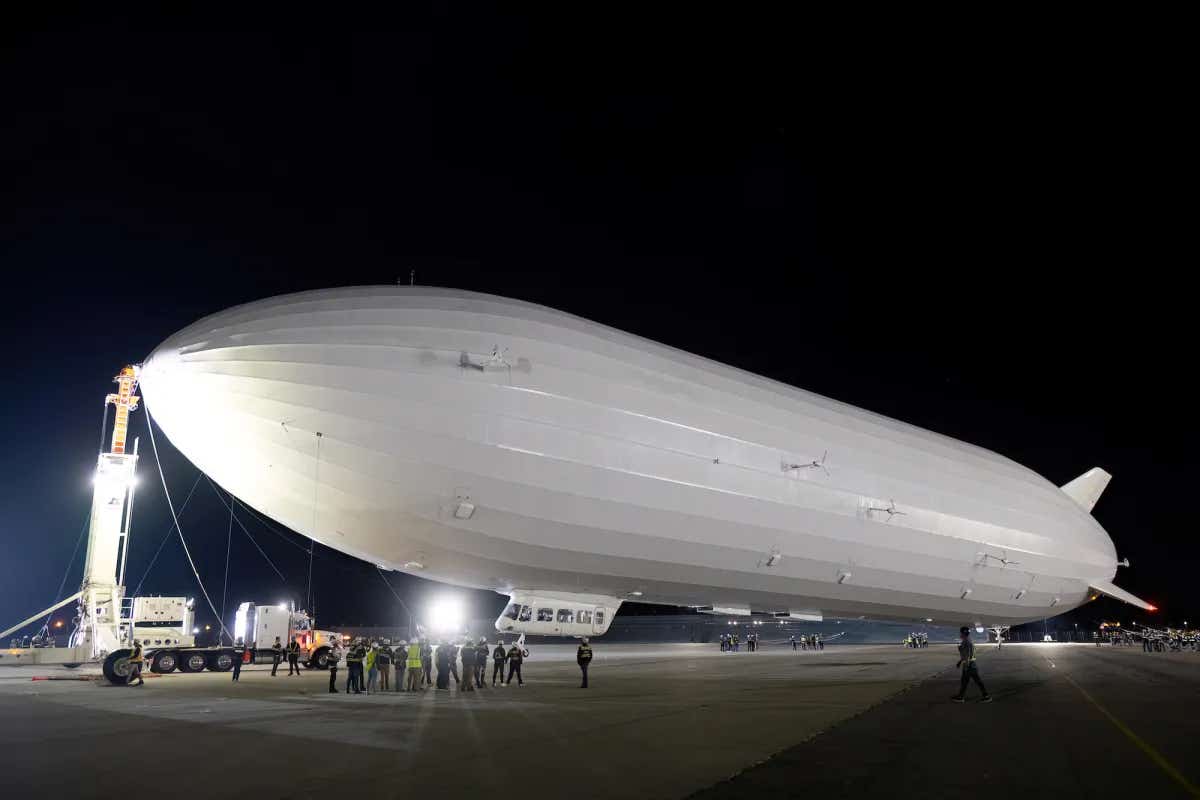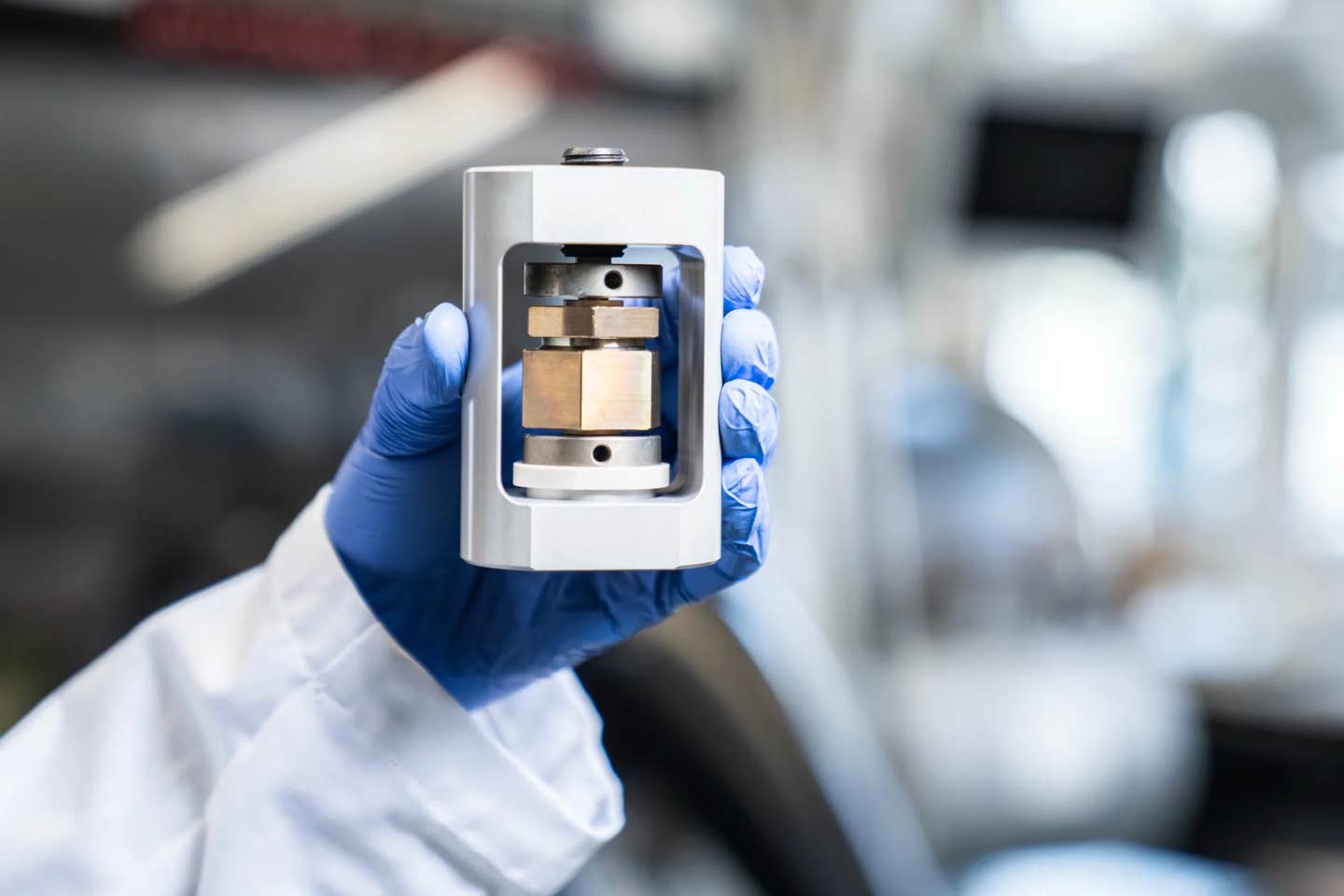Introducing Pathfinder 1: the world’s largest aircraft unveiled in Silicon Valley
In the heart of Silicon Valley, dawn breaks over an exciting new chapter in aviation as the world gets its first glimpse of Pathfinder 1

[Nov. 13, 2023: Staff Writer, The Brighter Side of News]
It represents a fusion of cutting-edge drone technology, featuring fly-by-wire controls, electric motors, and lidar sensing, all scaled up to create an airship longer than three Boeing 737s. (CREDIT: LTA Research)
In the heart of Silicon Valley, dawn breaks over an exciting new chapter in aviation as the world gets its first glimpse of Pathfinder 1, a groundbreaking prototype electric airship. LTA Research, the visionary creator behind this innovative project, envisions Pathfinder 1 as the harbinger of a new era in eco-friendly air travel and a catalyst for advancing humanitarian efforts worldwide, thanks to the generous backing of Google co-founder Sergey Brin.
The airship itself is a marvel to behold, with its snow-white, steampunk-inspired design visible from the bustling 101 highway. It represents a fusion of cutting-edge drone technology, featuring fly-by-wire controls, electric motors, and lidar sensing, all scaled up to create an airship longer than three Boeing 737s. This immense vessel holds the potential to transport substantial cargo across hundreds of miles, all while emitting zero carbon emissions.
"It's been 10 years of blood, sweat, and tears," shares LTA CEO Alan Weston in an exclusive interview with TechCrunch on the eve of the grand unveiling. "Now we must show that this can reliably fly in real-world conditions. And we're going to do that."
The road ahead promises a series of increasingly ambitious flight tests before Pathfinder 1 relocates to Akron, Ohio, where LTA Research is already planning the development of an even larger airship, the Pathfinder 3.
Related Stories
Ultimately, the company aspires to create a family of airships capable of providing disaster relief in areas where conventional infrastructure is damaged, as well as offering sustainable passenger transportation with zero carbon emissions.
Over the next year, this colossal airship will undoubtedly become a notable landmark in Silicon Valley. Its innovative materials and systems will be rigorously tested within proximity to tech giants like Google, Meta, and Amazon. Weston expresses his excitement, stating, "I'm excited about the potential of not building just one airship but laying the foundation for many airships to be built. The innovations and the technologies that we're about to demonstrate have the potential to lay the foundation for a new industry."
Pathfinder 1 stands as a true giant among aircraft, measuring a staggering 124.5 meters in length. It surpasses the size of current Goodyear airships and even the enormous Stratolaunch plane designed for launching orbital rockets. Not since the era of the gargantuan Hindenburg airship in the 1930s has the world seen an aircraft of this magnitude. Despite its visual similarities to the ill-fated Hindenburg, Pathfinder 1 is a testament to modern engineering, constructed primarily from new materials and advanced technologies.
LTA Research’s Pathfinder 1 airship prototype at Moffett Field in Mountain View, California. (CREDIT: LTA Research)
Unlike its hydrogen-filled predecessor, LTA's airship relies on stable helium as its lifting gas, contained within 13 colossal rip-stop nylon cells and monitored by lidar laser systems. The vessel's structural integrity is maintained by a rigid framework composed of 10,000 carbon-fiber reinforced tubes and 3,000 titanium hubs, enveloped in a lightweight synthetic Tedlar skin.
The Pathfinder 1 is propelled by twelve electric motors, which draw power from a combination of diesel generators and batteries, enabling vertical take-off and landing capabilities. These motors can propel the airship to speeds of up to 65 knots (75 mph), although initial flights will likely be conducted at lower speeds for safety considerations.
Pathfinder 1 during outdoor flight operations testing November 8 at Moffett Field in Mountain View, California. (CREDIT: LTA Research)
In a meticulously orchestrated event, the airship emerged silently from its WW2-era hangar at NASA's Moffett Field, guided by ropes held by a dedicated team of engineers, technicians, and ground crew. The operation occurred under the cover of darkness, not as an attempt to conceal anything, but rather because Pathfinder 1's flight test program commences with the first rays of morning sunshine.
The initial challenge that engineers aim to address is how the airship's approximately one million cubic feet of helium and its weather-resistant polymer skin respond to the warming effect of California's sunlight. Jillian Hilenski, senior mechanical engineer at LTA, explains, "We have sophisticated methodology that allows us to replicate real-world conditions using static test stands. However, dynamic on-ship flight tests provide the best data on the health and efficiency of the airship."
The Federal Aviation Administration (FAA) issued a special airworthiness certificate for Pathfinder 1 in early September, permitting test flights in and around Moffett Field, the Palo Alto airport, and over the southern portion of the San Francisco Bay. Initial tests will involve flights just a few feet above the ground, with the airship tethered to a mobile tripod mast. These will be followed by progressively more complex maneuvers around Moffett Field and flights over the bay.
Alan Weston places a high priority on safety as he endeavors to reintroduce rigid airships to North American skies and, eventually, worldwide. The first 50 flights of Pathfinder 1, covered by the FAA certificate, will restrict altitude to no higher than 1,500 feet and will employ two pilots instead of the initially intended single pilot.
"I can count the number of companies in the lighter-than-air space on my hands, and we all have a lot to lose if anybody has a serious problem," Weston emphasizes. LTA collaborates closely with the FAA to ensure that their creations follow a safe and sensible path to full certification. Weston reflects on the history of airships, noting, "The last maiden flight of an airship like this was the Graf Zeppelin II in 1938. The FAA wasn't even around then."
While airships may not replace conventional aircraft in the future of aviation, they hold immense potential as a complementary solution that reduces the carbon footprint of air travel. Weston acknowledges this reality, stating, "I can't see airships replacing aircraft, but I do see a niche for airships to be part of the transportation architecture that reduces the carbon footprint of air travel."
Another critical niche for Pathfinder 1 and future airships could lie in disaster response efforts. Natural disasters such as earthquakes, volcanic eruptions, and hurricanes often render traditional infrastructure unusable. Sergey Brin, the co-founder of Google and the generous patron behind this project, also funds a nonprofit organization called Global Support and Development (GSD). GSD's mission is to provide humanitarian aid within the crucial first 24 to 96 hours following a disaster.
Brin established GSD in 2015, inspired by his own experiences using his superyacht to deploy medical personnel to the scene of a cyclone in the South Pacific. The nonprofit has since partnered with YachtAid Global and has acquired its purpose-built vessel, the MV Dawn, capable of rapidly transporting doctors, aid workers, and life-saving supplies.
While Pathfinder 1 can currently carry approximately four tons of cargo in addition to its crew, water ballast, and fuel, future humanitarian airships will require substantially larger capacities. These advanced airships are also likely to incorporate zero-carbon technologies like hydrogen fuel cells for power, according to Jillian Hilenski. Achieving this goal will involve a rigorous and methodical validation process for new technologies, ensuring they meet the safety and reliability standards expected of commercial jets.
"What excites me about what we've done so far is that we've shown to ourselves, and we hope to show to the rest of the world, that we can scale in size and productivity," Weston concludes optimistically. "And I believe in our potential to scale up again in the future."
Note: Materials provided above by The Brighter Side of News. Content may be edited for style and length.
Like these kind of feel good stories? Get the Brighter Side of News' newsletter.



